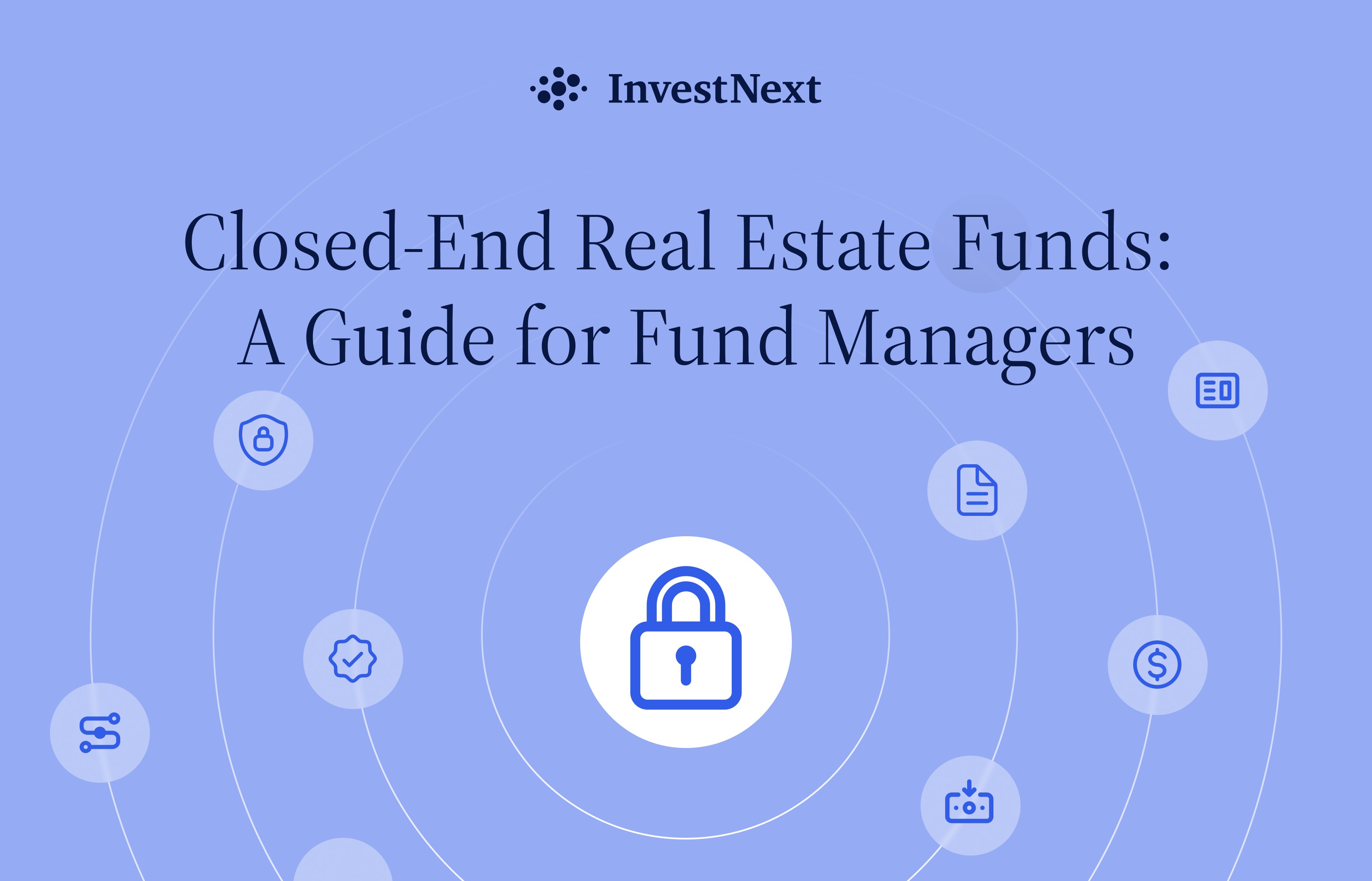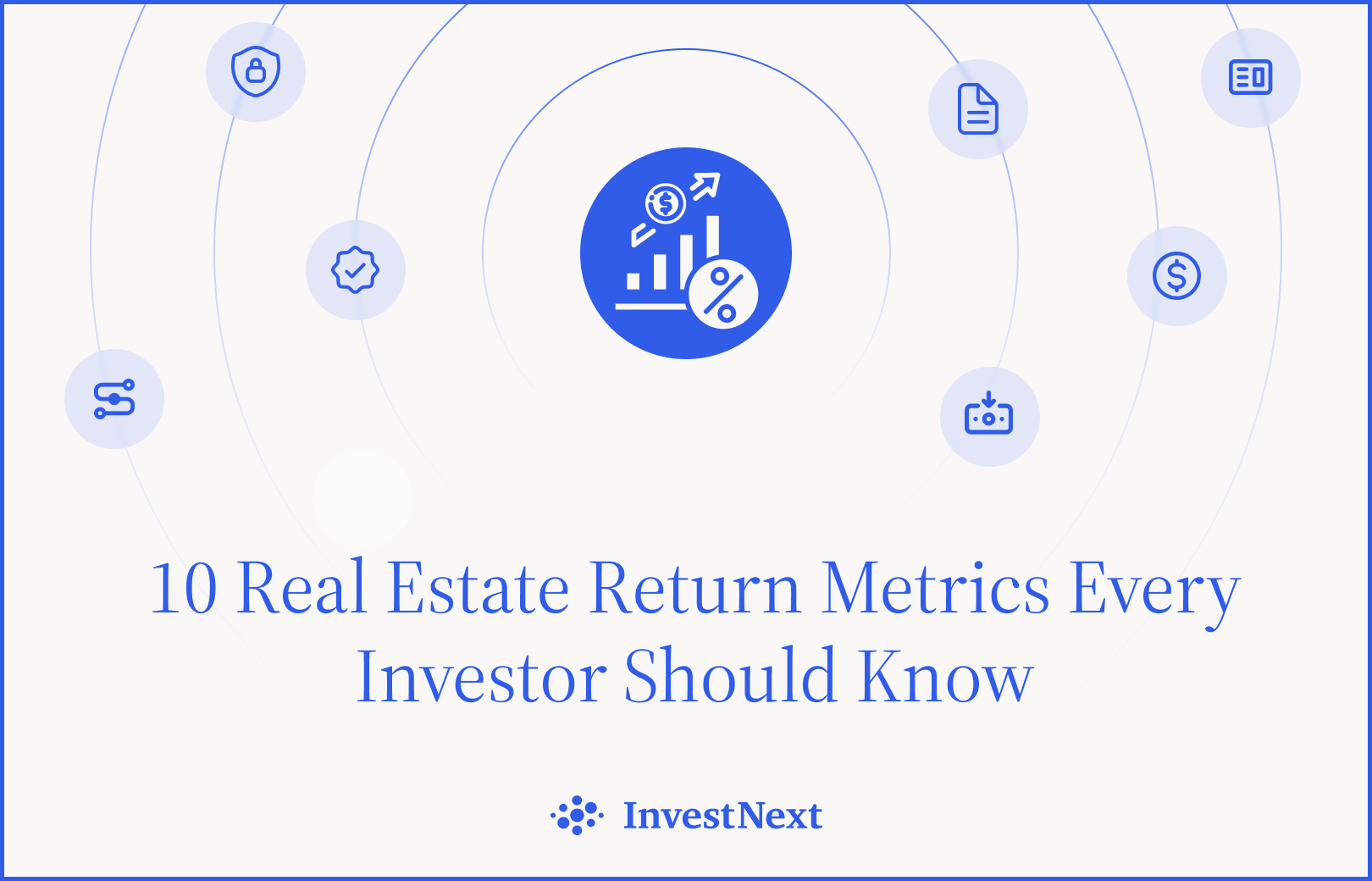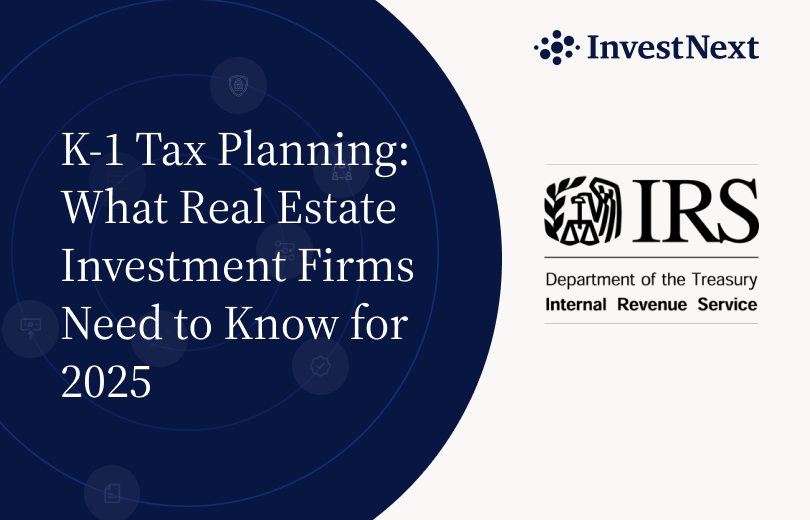At InvestNext, we’ve observed a significant evolution in how real estate investment firms structure and manage closed-end funds. While these vehicles remain foundational to real estate investment, the growing complexity of fund structures and rising investor expectations create new operational challenges for managers at every level.
Through our work with fund managers across the industry, we’ve seen how the traditional approach to closed-end funds is shifting. Managers who once relied on simple structures now navigate increasingly sophisticated investment strategies, complex waterfall calculations, and heightened investor reporting demands. This evolution makes understanding both the fundamentals and modern best practices crucial for success.
This comprehensive guide examines closed-end real estate funds from the ground up – from their basic structure through advanced operational considerations.
Whether you’re exploring your first fund launch or managing an established portfolio, we’ll explore how these investment vehicles work and how modern managers are adapting to today’s demands.
What are Closed End Real Estate Funds?
Closed-end real estate funds work differently from standard investment options. These specialized funds raise capital through an original public offering (IPO) that issues a set number of shares 1. The fund’s portfolio maintains a fixed size and targets specific real estate sectors based on its strategy.
Definition and key characteristics
Closed-end real estate funds have several distinct features that set them apart:
- The share structure remains fixed after the initial public offering (IPO) with no additional shares issued
- Investors can trade shares actively on stock exchanges during market hours
- A team of professionals manages and oversees the fund
- The fund can make investments using borrowed money
- Share prices fluctuate based on market demand and might not match the net asset value (NAV)
Comparison with open-end funds
Closed-end and open-end real estate funds have a fundamental difference in their structure and how they operate:
| Feature | Closed-End Funds | Open-End Funds |
| Share Creation | Fixed one-time offering | Continuous share issuance 2 |
| Trading | Exchange-traded daily | End-of-day pricing |
| Liquidity | Limited to market trading | Regular redemption options |
| Capital Deployment | More efficient deployment | May hold cash reserves 3 |
Types of closed-end real estate funds
Closed-end real estate funds include debt funds, equity investments and hybrid structures. Fund managers often focus on specific property sectors like multi-family housing, commercial properties or development projects 3. These investments run between 3-5 years and can extend to 8-10 years 3. This longer timeline lets managers execute their investment strategies without worrying about constant liquidity for redemptions.
Market dynamics shape these funds’ pricing mechanism. The shares often trade at premiums or discounts to their NAV 1. Smart investors can use this unique feature to profit from market inefficiencies while getting professional real estate portfolio management.
Modern Fund Operations and Administration
The operational landscape for closed-end funds has transformed significantly in recent years. While the fundamental structure remains consistent, how these funds operate has evolved to meet modern demands for efficiency, transparency, and scale.
Evolution of Fund Administration
Today’s closed-end funds require sophisticated operational infrastructure that extends well beyond basic accounting and investor relations. Modern fund administration encompasses:
- Comprehensive capital event management, from initial raise through final dissolution
- Complex waterfall calculations that account for multiple share classes and investor types
- Integrated banking and payment processing that ensures accurate, timely distributions
- Robust reporting systems that provide institutional-grade transparency to investors
The challenge for many managers lies not just in understanding these requirements, but in implementing them efficiently while maintaining accuracy and compliance.
Technology’s Role in Modern Fund Management
Modern fund management platforms have transformed how managers handle operational complexity. By integrating crucial functions like investor relations, capital events, and financial reporting, these systems enable managers to:
- Scale operations without proportional increases in administrative overhead
- Maintain accuracy across complex calculations and reporting requirements
- Provide institutional-grade investor experiences regardless of fund size
- Focus on investment strategy rather than administrative tasks
Net Asset Value (NAV) and market price
A fund’s NAV shows its per-share value of underlying assets after subtracting liabilities 5. Market prices often differ from NAV, which creates chances for strategic investment:
| Price Relationship | Description | Implication |
| Premium | Market price > NAV | Shares trading above asset value |
| Discount | Market price < NAV | Potential buying chance |
Use of leverage
Leverage is a strategic tool that improves potential returns. Most closed-end funds use it to increase their investment opportunities 6. The main benefits include:
- Higher returns through borrowed capital
- Knowing how to profit from interest rate spreads
- Better portfolio diversification options
Fund managers maintain leverage ratios between 33% and 50% of total fund assets 6. They must balance the benefits carefully against higher volatility and risk exposure.
Advantages and Disadvantages for Investors
Investment professionals now see unique advantages and challenges in closed-end real estate funds for investors who want real estate exposure. Recent studies show that these investment vehicles need investors to think about several factors that affect their returns.
Potential for higher returns
Closed-end real estate funds can generate better returns because they use borrowed money effectively. Fund managers typically work with leverage ratios between 33% to 50% of total assets 6. This approach gives managers the freedom to seize market opportunities since they don’t need to keep large cash reserves for redemptions 3.
Professional management and diversification
Professional management elevates portfolio administration with expert-level oversight. The benefits include:
- Properties and markets of all types become accessible
- Smart decisions about what to buy and when to invest
- Expert handling of complex deals
- Protection against market ups and downs
Limited liquidity and price volatility
Recent market data shows closed-end funds often trade at deep discounts compared to their net asset value. Studies indicate these discounts have reached their widest historical levels during periods of market stress 3. This pricing pattern creates opportunities and challenges for investors:
| Aspect | Effect |
| Trading Flexibility | Daily exchange trading |
| Price Discovery | Market-driven valuations |
| Liquidity Risk | Potential difficulty in large transactions |
| Volatility | Greater price fluctuations than direct property |
Tax considerations
Investors must closely examine the tax structure of closed-end real estate funds. Public pension funds make up much of the institutional investors in these vehicles. This points to tax benefits for specific investor classes 3. The tax implications from using leverage and complex investment strategies need professional guidance to work properly.
Closed-end real estate funds have largely underperformed in the last two decades. Recent analysis shows Private Equity Real Estate (PERE) funds delivered poor net returns compared to other options and their fees 7. These results highlight why investors need smart timing and deep research before making investment decisions.
How to Invest in Closed End Real Estate Funds
Investors need experienced, trustworthy general partners to succeed in closed-end real estate funds. These specialized funds have shown remarkable performance metrics. Data shows they exceeded the MSCI U.S. Quarterly Property Index by a factor of 1.07 from inception through December 2021 8.
Evaluating fund performance and management
Successful investing starts with a full picture of fund performance metrics and management capabilities. Research data reveals that 58% of funds performed better than the unlevered index. This number decreases to about 50% after considering fund-specific leverage 8. The essential evaluation criteria include:
- Historical NAV performance trends
- Management team’s track record
- Investment strategy arrangement
- Operating expense ratios
- Distribution sustainability
Analyzing discounts and premiums to NAV
Market price and NAV relationships create valuable chances for investors. Research shows that entry timing greatly affects returns. Data reveals that 72% of funds from 2005-2007 vintages performed poorly on both unlevered and levered basis 8. Let’s look at this performance comparison:
| Price Relationship | Investment Implication | Risk Level |
| Significant Discount | Potential value opportunity | Moderate |
| At NAV | Neutral entry point | Low |
| Premium | Requires strong justification | High |
Strategies for buying and selling
Trading strategies work best when they target market inefficiencies and timing. Research shows that closed-end funds have underperformed significantly in the last two decades. Private Equity Real Estate funds have delivered challenging net returns compared to other investment options 7.
Role in a diversified investment portfolio
A broader investment strategy needs thorough analysis of portfolio allocation and risk management. Professional investors utilize institutional-grade processes to manage their portfolios. They focus on:
- Strategic asset allocation
- Risk-adjusted return expectations
- Correlation with other investments
- Liquidity management requirements
Automated systems and expert administration services help implement these strategies effectively. These tools enable quick scaling and ensure investment operations remain transparent and precise.
Conclusion
Closed-end real estate funds continue to evolve as market conditions and investor expectations change. Success in this environment requires more than just understanding the basics – it demands a thorough grasp of both fundamentals and modern operational best practices.
InvestNext’s platform delivers the essential tools needed to manage closed-end funds effectively.
Our integrated solutions support comprehensive capital event management, automated waterfall calculations, and institutional-grade investor reporting.
From initial capital raise through final dissolution, the platform handles complex distribution plans, multiple equity classes, and automated position tracking—all while maintaining the highest standards of accuracy and transparency.
Want to learn more about modern fund administration? Schedule a demo to explore how technology is transforming closed-end fund management.








